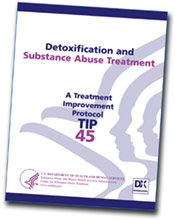Treatment Protocol Focuses
on Detoxification
By Riggin Waugh
 SAMHSA's
Center for Substance Abuse Treatment (CSAT) recently
released Treatment Improvement Protocol 45 (TIP 45)—Detoxification
and Substance Abuse Treatment. SAMHSA's
Center for Substance Abuse Treatment (CSAT) recently
released Treatment Improvement Protocol 45 (TIP 45)—Detoxification
and Substance Abuse Treatment.
Prepared by a consensus panel of experts in detoxification
services, the TIP provides the clinical evidence-based
guidelines, tools, and resources necessary to help substance
abuse counselors and clinicians treat clients who are
dependent on substances of abuse.
The new publication is a revision of TIP 19, Detoxification
From Alcohol and Other Drugs, which was published
by CSAT in 1995.
-
Urgent Needs. TIP 45 emphasizes
the importance of detoxification as one component
in the continuum of health care services for substance-related
disorders. It reinforces the urgent need for non-traditional
settings—such as hospital emergency departments,
medical and surgical wards, and acute care clinics—to
be prepared to help get patients in need of detoxification
services into treatment as quickly as possible.
-
Treatment Settings. Matching patients
to appropriate treatment settings presents a challenge
to detoxification programs, given the wide variety
of settings and the unique needs of individual patients.
Matching patients' clinical needs with the appropriate
care setting in the least restrictive and most cost-effective
manner is a complex task.
Another challenge for detoxification programs is to
provide effective linkages to substance abuse treatment
services. Patients often leave detoxification without
followup to the treatment needed to achieve long-term
abstinence.
According to this TIP, each year, at least 300,000 patients
with substance use disorders or acute intoxication obtain
inpatient detoxification in general hospitals; additional
numbers obtain detoxification in other settings. Only
20 percent of people discharged from acute care hospitals
receive substance abuse treatment during that hospitalization.
Only 15 percent of people who are admitted to a detoxification
program through an emergency department, and then discharged,
go on to receive treatment.
Management of withdrawal without medication may well
serve young people in good health with no history of
previous withdrawal reactions. However, supervisory personnel
in non-medical settings should be trained to identify
life-threatening symptoms and to solicit help through
the emergency medical system as needed.
-
Protocols. TIP 45 provides medical
information on detoxification protocols for specific
substances as well as considerations for individuals
with co-occurring medical conditions including mental
disorders. Although the TIP is not intended to take
the place of medical texts, it provides practitioners
with an overview of common medical complications
seen in people who use substances.
The existence of co-occurring medical disorders also
influences the setting in which detoxification occurs.
It is highly desirable that primary care practitioners—physicians,
physician assistants, and nurse practitioners—with
some experience in substance abuse treatment assess people
undergoing detoxification.
People with a history of severe withdrawals, multiple
withdrawals, delirium tremens (a potentially fatal syndrome
associated with alcohol withdrawal), or seizures are
not good candidates for detoxification programs in non-medical
settings.
-
Sensitivity. Physicians, nurses,
substance abuse counselors, and administrators are
in a unique position to ensure a safe and humane
withdrawal from substance abuse as well as to cultivate
patients' entry into treatment. Regardless of their
role in providing detoxification services, all personnel
should keep in mind that patients undergoing detoxification
are in the midst of a personal and medical crisis.
For many patients, this crisis represents a window
of opportunity to acknowledge their substance abuse
problem and become willing to seek treatment.
The primary audiences for this TIP include substance
abuse treatment counselors, administrators of detoxification
programs, directors of single state agencies, psychiatrists,
and other physicians working in the field.
To obtain TIP 45, Detoxification and Substance Abuse
Treatment, contact SAMHSA's National Clearinghouse
for Alcohol and Drug Information at P.O. Box 2345, Rockville,
MD 20847-2345. Telephone: 1 (800) 729-6686 (English and
Spanish) or 1 (800) 487-4889 (TDD). Ask for NCADI No.
BKD541. Online, TIP 45 will be available soon at www.kap.samhsa.gov/products/
manuals/tips/numerical.htm. 
« See Also—Previous Article
See Also—Next
Article »
Back to Top
|




